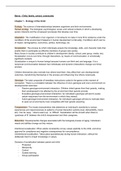Berns - Child, family, school, community
Chapter 1 - Ecology of the Child
Ecology: The science of interrelationships between organisms and their environments.
Human ecology: The biological, psychological, social, and cultural contexts in which a developing
person interacts and the consequent processes that develop over time.
Adaptation: The modification of an organism or its behavior to make it more fit for existence under the
conditions of the environment (happens in human development continually). Conditions which can be
of impact: demographics, economics, politics, technology, etc.
Socialization: The process by which individuals acquire the knowledge, skills, and character traits that
enable them to participate as effective members of groups and society.
Many forces in society contribute to children’s development (family, school, peer group, media, etc).
Socialization occurs over time, through interactions, by means of communication, in emotionally
significant contexts.
Socialization is unique to human beings because humans can think and use language. It is a
reciprocal (communication between two individuals) and dynamic (interactions change over time)
process.
Children themselves also motivate how others treat them: they affect their own developmental
outcomes, transforming themselves in the process and influencing how others reciprocate.
Genotype: The total composite of hereditary instructions coded in the genes at the moment of
conception. There is a correlation between the influence of one’s genotype and one’s environment on
developmental outcomes.
- Passive genotype-environment interaction: Children inherit genes from their parents, making
them predisposed to be affected by the environment their parents provide.
- Evocative genotype-environment interaction: An individual’s genotype will tend to evoke
certain responses from the environment in which they interact.
- Active genotype-environment interaction: An individual’s genotype will tend to motivate them
to seek out environments most compatible with their genetic prewiring.
Temperament: The innate characteristics that determine an individual’s sensitivity to various
experiences and responsiveness to patterns of social interaction (activity level, distractibility, mood,
etc). Can be ‘easy’, ‘slow-to-warm-up’, or ‘difficult’. Socialization will be smooth when there is
‘goodness of fit’ between the child’s temperament and their caregivers.
Maturation: Developmental changes associated with the biological process of aging. Individual’s
needs and abilities change as they mature.
Intentional socialization: When adults consistently convey values explicitly to the child, and show
approval for compliance and negative consequences for noncompliance.
Unintentional socialization: Takes place spontaneously during human interaction, without the
deliberate intent to impart knowledge or values.
Domains of socialization between parent and child:
- Protection
- Reciprocity
- Control
- Guided learning
- Group participation
,Adults are affected directly by social change, and the way they adapt to this change may then
indirectly affect children. Social change, especially technologic and scientific, can influence the goals
of child rearing and education (for example: the modern focus on intellectual development). The
concept of childhood changes throughout the centuries.
Scientific theory: An organized set of statements that explains observations, integrates different facts
or events, and predicts future outcomes.
Bioecological: Refers to the role organisms play in shaping their environment over time.
Bronfenbrenner’s bioecological model of human development: Proposes that researchers examine
various ecological settings in which the child participates to explain individual differences in children’s
development.
- Microsystem: Activities and relationships with significant others experienced by a developing
person in a particular small setting.
- Family
- School
- Peer group
- Community/neighborhood
- Media
- Mesosystem: Linkages and interrelationships between two or more of a person’s
microsystems. The more numerous the qualitative links between the child’s microsystems, the
more impact they have on socialization.
- Exosystem: Settings in which children do not actually participate, but which affect them in one
of their microsystems (for example: parents’ jobs).
- Macrosystem: The society and subculture to which the developing person belongs, with
particular reference to the belief systems, lifestyles, patterns of social interaction, and life
changes.
- Society: Community, nation, or broad grouping of people having common traditions,
institutions, and collective activities/interests.
- Ethnicity: An ascribed attribute of membership in a group in which members identify
themselves by national origin, culture, race, or religion.
- Culture: The learned behavior, including knowledge, belief, art, morals, law, customs,
and traditions, that is characteristic of the social environment in which an individual
grows up.
- Low-context macrosystem: Culture generally characterized by rationality, practicality,
competition, individuality, and progress.
- High-context macrosystem: Culture generally characterized by intuitiveness,
emotionality, cooperation, group identity, and tradition.
- Chronosystem: Temporal changes in ecological systems or within individuals, producing new
conditions that affect development.
Indicators to examine the well-being of children:
- Family and social environment
- Economic circumstance
- Health care
- Psychical environment and safety
- Behavior
- Education
- Health
Chapter 2 - Ecology of Socialization
, Dynamic socialization processes: The aims and methods change as do children.
Reciprocal socialization processes: Children contribute to their own developmental outcomes.
Affected by:
- Biological factors (genetics, evolution, hormones)
- Experience-expectant: The neural connections that develop under genetic influence,
independent of experience, activity, or stimulation.
- Sociocultural factors
- Experience-dependent: The neural connections that develop in response to
experience.
- Interactive factors (the child’s receptivity to socialization)
Aims of socialization:
- Develop a self-concept
- Self-concept: An individual’s perception of his or her identity as distinct from others.
- Self-esteem: The value one places on one’s identity.
- Autonomy, self-regulation, control
- Self-evaluation: When attitudes/expectations of significant others are incorporated
into one’s personality.
- See ‘Erikson’s stages of psychosocial development’ below.
- Enable self-regulation
- Self-regulation: the ability to control one’s impulses, behavior, and/or emotions until
an appropriate time, place, or object is available for expressing them.
- Empower achievement
- Teach appropriate social roles
- Implement developmental skills
- Social, emotional, and cognitive skills for children to function successfully in society.
- Developmental tasks arise from societal pressures on individuals according to their
development, and differ from society to society.
Erikson’s stages of psychosocial development:
Generativity: Interest in establishing and guiding the next generation.
Agents of socialization:
- Family





